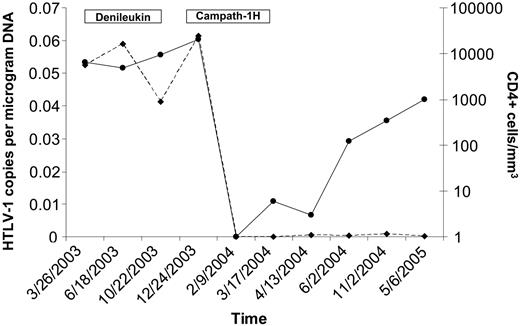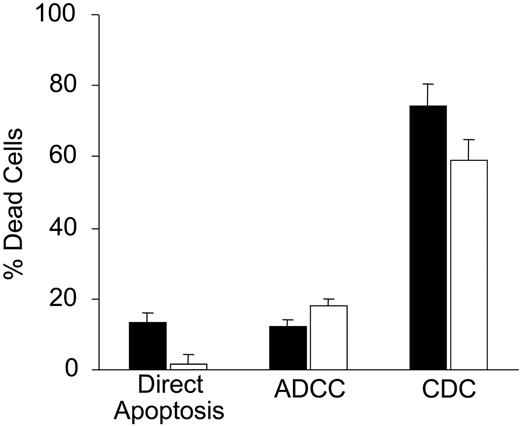Abstract
Adult T-cell leukemia (ATL) is a highly chemoresistant and usually fatal T-cell malignancy due to the human T-cell lymphotropic virus-1 (HTLV-1). After chemotherapy failure, antiretrovirals and interferon-α (IFN-α) produce brief responses followed by progression and death. More effective agents and new approaches to detect and treat minimal residual disease are needed. ATL cells express CD52, the target of the antibody alemtuzumab, which is active in a preclinical model of ATL and is cytotoxic for p53-deficient cells. A patient with refractory chronic ATL in transformation achieved longer than a 1-year complete hematologic response following 12 weeks of outpatient subcutaneous alemtuzumab. Persistent suppression of HTLV-1 viral load, even at recovery of T cells, after alemtuzumab and efficient in vitro complement-mediated cytotoxicity of primary ATL cells with mutated TP53 were observed. The unprecedented response and the profound suppression of HTLV-1 viral load observed in this patient suggest that further clinical investigation of alemtuzumab in ATL is warranted.
Introduction
Approximately 20 million children and adults worldwide are infected with human T-cell lymphotropic virus-1 (HTLV-1).1 About 3% to 5% of them develop adult T-cell leukemia (ATL), an aggressive malignancy of CD4+CD25+ T lymphocytes with profound public health impact in HTLV-1 endemic areas.2 Complete responses even with intensive chemotherapy are rare, and survival is only 6 to 24 months.3 A dysfunctional TP53 pathway and constitutive nuclear factor–κB (NF-κB) activation contribute to chemoresistance.4,5 Moreover, the definition and monitoring of subclinical disease is challenging. While HTLV-1 viral loads increase with progression from smoldering to acute phase and with increasing tumor burden,6 changes following therapy in ATL have not been well characterized. Alemtuzumab is a humanized immunoglobulin G1 κ (IgG1 κ) monoclonal antibody directed against CD52, a glycosyl-phosphatidylinositol (GPI)–linked protein expressed on normal and malignant leukocytes including ATL cells.7 Alemtuzumab is active in a mouse model of ATL.8
Study design
Approval for this study was obtained from the OSU Institutional Review Board (OSU 1997CO194). Informed consent was provided according to the Declaration of Helsinki. Quantitative real-time polymerase chain reaction (PCR) was performed with genomic DNA from peripheral blood mononuclear cells (PBMCs) using established primers and conditions.9 As control, 18S rRNA gene copies were measured simultaneously in separate tubes using an 18S standard curve. Triplicate sample, standard curves, and no-template control reactions were performed using the Prism 7700 Sequence Detection System (Applied Biosystems, Foster City, CA). Data were analyzed using SDS v1.9 software. Average PCR efficiencies of the tax and r18S standard curves were 103% ± 3.7% and 99.9% ± 3.0%, respectively. Interassay and intra-assay variabilities and sensitivities obtained were similar to those described previously.9 Copy numbers of the tax gene were first normalized to 18S copies and then to 1 μg total DNA. For cytotoxicity, fresh ATL cells from subject “ATL-1” and archived primary acute ATL cells from another patient (ATL-2), both procured with IRB approval, were incubated for 4 hours in media with alemtuzumab and anti-Fc IgG (both 10 mg/mL), alemtuzumab (10 mg/mL) with PBMCs at an effector-target ratio of 25:1, or alemtuzumab (10 mg/mL) in media with 30% human serum. Cell death was determined by propidum iodide (PI) staining and fluorescence-activated cell sorter (FACS) analysis for apoptosis and complement-dependent cytotoxicity (CDC) or by chromium-51 release assay for antibody-dependent cellular cytotoxicity (ADCC).10,11 Genomic DNA from ATL-1 and ATL-2 cells was amplified using primers for TP53 exons 5 to 9 and assessed for mutation using denaturing gradient gel electrophoresis and confirmatory sequencing of mutations as previously published.12
Results and discussion
A 63-year-old woman was diagnosed with chronic ATL in July 2000. Oral chlorambucil and cyclophosphamide produced a modest reduction of the lymphocytosis, but in July 2002 she developed peripheral blood (PB) and biopsy-proven cutaneous progression. Interferon-α (IFN-α) was started in combination with zidovudine (AZT), stavudine (d4T), and lamivudine (3TC). However, after variable intervals, antiviral drugs were discontinued due to toxicity. In January 2003, thalidomide was added to IFN-α. Both drugs were stopped in March 2003, when the patient presented to The Ohio State University with CD4+ T-cell lymphocytosis (6.4 × 109/L) and new deforming cutaneous lesions. HTLV-1 serology and PCR on PBMCs were positive. Computed tomography (CT) scans showed no lymphadenopathy, hepatosplenomegaly, or pulmonary or bone lesions. Serum calcium levels were normal. Serum lactate dehydrogenase (LDH) was 265 IU/mL (normal: 190 IU/mL or below). The bone marrow was extensively involved by an abnormal population of T cells expressing CD2, CD3, CD4, CD5, CD25, and CD52 but negative for CD7, CD8, and CD26. Denileukin diftitox, 18 μg/kg/d for 5 days every 3 weeks, resulted in near disappearance of the cutaneous lesions but only modest improvement of the lymphocytosis (Figure 1), and after 10 cycles (October 2003), was discontinued. By November 2003, progression was already noted and reinitiation of denileukin diftitox was ineffective. Alemtuzumab (30 mg subcutaneously thrice weekly for 12 weeks) was started. Within 4 weeks, skin and PB had cleared (Figure 1). A bone marrow biopsy at completion of alemtuzumab (May 2004) and 3 months later (December 2004) showed no morphologic or immunophenotypic evidence of disease. All therapy was outpatient. Neutropenia and asymptomatic cytomegalovirus (CMV) reactivation developed after 8 to 9 weeks of therapy. Alemtuzumab was held for 2 weeks, the neutrophil count recovered on filgrastim, and CMV was rapidly cleared with valganciclovir. At completion of alemtuzumab persistent neutropenia required intermittent use of filgrastim. As of May 2005, the patient had no clinical or hematologic evidence of disease, normal neutrophil count off filgrastim, and normal lymphocyte count.
While denileukin diftitox only resulted in a cutaneous response, alemtuzumab produced a dramatic decline of PB lymphocytosis and HTLV-1 viral load, which remained at the lower limit of detection, even at recovery of PB CD4+ T cells after alemtuzumab (Figure 1). Analysis of cytotoxicity with the patient's cells (ATL-1) and with an archived sample of primary acute ATL cells (ATL-2) showed that, in the presence of human serum, alemtuzumab effectively induced CDC (65% cytotoxicity at 4 hours), whereas ADCC and direct apoptosis were negligible (Figure 2). The cytotoxicity of alemtuzumab in ATL-2 cells carrying a nonsense exon 5 TP53 mutation (data not shown) parallels that observed in CLL with 17q deletion and/or mutations.12
The activity of alemtuzumab in a mouse model of ATL8 and in patients with other refractory T-cell malignancies or CLL with mutated or absent TP5312-16 provides a strong rationale for its use in ATL. The clinical response and durable HTLV-1 viral load reduction achieved in this patient are very encouraging because comparable reductions in tumor burden and viral loads have only been observed with allogeneic hematopoietic stem cell transplantation (HSCT).17-19 Although its use in ATL has been previously cited20 and, more recently, early phase 2 results with single-agent intravenous alemtuzumab were presented in abstract form,21 this is the first analysis of the combined effects of subcutaneous alemtuzumab on clinical response, HTLV-1 viral loads, and in vitro cytotoxicity in ATL. The relevant mechanism of response to alemtuzumab in ATL remains undefined. While the activity of alemtuzumab in the model of Zhang et al8 requires activating Fcγ receptors, CDC was the dominant in vitro mechanism in our 2 ATL samples. In CLL high-affinity alleles for FcγRIIa and FcγRIIIa do not correlate with clinical response to alemtuzumab in vivo, suggesting FcγR-independent mechanisms.22 Studies of FcγR polymorphism and ADCC in T-cell lymphoma patients treated with alemtuzumab are in progress as part of a prospective study.
Reduction of CD4+ T cells and HTLV-1 viral load following denileukin diftitox and alemtuzumab. Results are depicted as HTLV-1 copies per microgram of DNA relative to time (♦). The number of CD4+ cells per cubic millimeter was determined by FACS analysis using antihuman CD4 antibody. Results are depicted as CD4+ cells per cubic millimeter relative to time (•). Denileukin diftitox and alemtuzumab treatment periods are indicated as bars above the line graphs.
Reduction of CD4+ T cells and HTLV-1 viral load following denileukin diftitox and alemtuzumab. Results are depicted as HTLV-1 copies per microgram of DNA relative to time (♦). The number of CD4+ cells per cubic millimeter was determined by FACS analysis using antihuman CD4 antibody. Results are depicted as CD4+ cells per cubic millimeter relative to time (•). Denileukin diftitox and alemtuzumab treatment periods are indicated as bars above the line graphs.
Alemtuzumab-induced death in human ATL cells in vitro. Primary ATL cells from the patient described in this report (ATL-1) (▪) and from a previous patient with acute ATL (ATL-2) (□) were incubated for 4 hours in media with alemtuzumab and anti-Fc IgG (both 10 μg/mL) (direct apoptosis), alemtuzumab (10 μg/mL) with PBMCs at an effector-target ratio of 25:1 (ADCC), or alemtuzumab (10 μg/mL) in media with 30% human serum (CDC). Cell death was determined by propidum iodide staining with FACS analysis for direct apoptosis and CDC, or a chromium-51 release assay for ADCC. ATL-2 cells carried a mutated TP53 gene. Experiments were done in triplicate, and results are expressed as average. Bar height reflects the average percentage of dead cells as compared with untreated control values.
Alemtuzumab-induced death in human ATL cells in vitro. Primary ATL cells from the patient described in this report (ATL-1) (▪) and from a previous patient with acute ATL (ATL-2) (□) were incubated for 4 hours in media with alemtuzumab and anti-Fc IgG (both 10 μg/mL) (direct apoptosis), alemtuzumab (10 μg/mL) with PBMCs at an effector-target ratio of 25:1 (ADCC), or alemtuzumab (10 μg/mL) in media with 30% human serum (CDC). Cell death was determined by propidum iodide staining with FACS analysis for direct apoptosis and CDC, or a chromium-51 release assay for ADCC. ATL-2 cells carried a mutated TP53 gene. Experiments were done in triplicate, and results are expressed as average. Bar height reflects the average percentage of dead cells as compared with untreated control values.
The observed normalization of CD4+ T cells after alemtuzumab despite persistently suppressed HTLV-1 viral loads is important because of appropriate concerns about the immunosuppressive properties of alemtuzumab. In principle, alemtuzumab could lead not only to opportunistic infections, but also to disease acceleration in ATL by further impairing immune surveillance. However, immune responses in ATL after therapy have not been well studied outside of allogeneic HSCT, where hematopoietic reconstitution is due to donor-derived HTLV-1–negative cells.23 Recovery of autologous CD4+ T cells without a rise in HTLV-1 viral load, as seen here, could reflect the expansion of endogenous HTLV-1–negative T cells, suggesting that alemtuzumab may have some selectivity for HTLV-1–infected T cells. This hypothesis is consistent with the current theory that expansion of HTLV-1–infected T cells is the predominant mechanism of maintenance of proviral load.24 The role of pre-exposure to denileukin diftitox in this patient's response to alemtuzumab could not be addressed, but clinical trials with alemtuzumab in combination with immunotoxins, chemotherapy, or antivirals should be considered. The role of maintenance alemtuzumab vis-à-vis HTLV-1 viral loads should also be studied. The safety and ease of administration of subcutaneous alemtuzumab in CLL25 suggest that this may be a feasible therapy even in areas remote from tertiary care centers, where most ATL patients live.
Prepublished online as Blood First Edition Paper, August 2, 2005; DOI 10.1182/blood-2005-01-0335.
Supported in part by National Cancer Institute (NCI) grants K23 CA10215-02 (P.P.), T32 CA009338 (A.M., R.A.B.), and P01 CA95426 (M.A.C., J.C.B., A.M.), and by the Leukemia and Lymphoma Society (J.C.B.) and the D. Warren Brown Foundation (J.C.B.). J.C.B. is a clinical scholar of the Leukemia and Lymphoma Society.
The publication costs of this article were defrayed in part by page charge payment. Therefore, and solely to indicate this fact, this article is hereby marked “advertisement” in accordance with 18 U.S.C. section 1734.
The authors thank Michael D. Lairmore, PhD, DVM, for his suggestions and critical review of the manuscript.



This feature is available to Subscribers Only
Sign In or Create an Account Close Modal